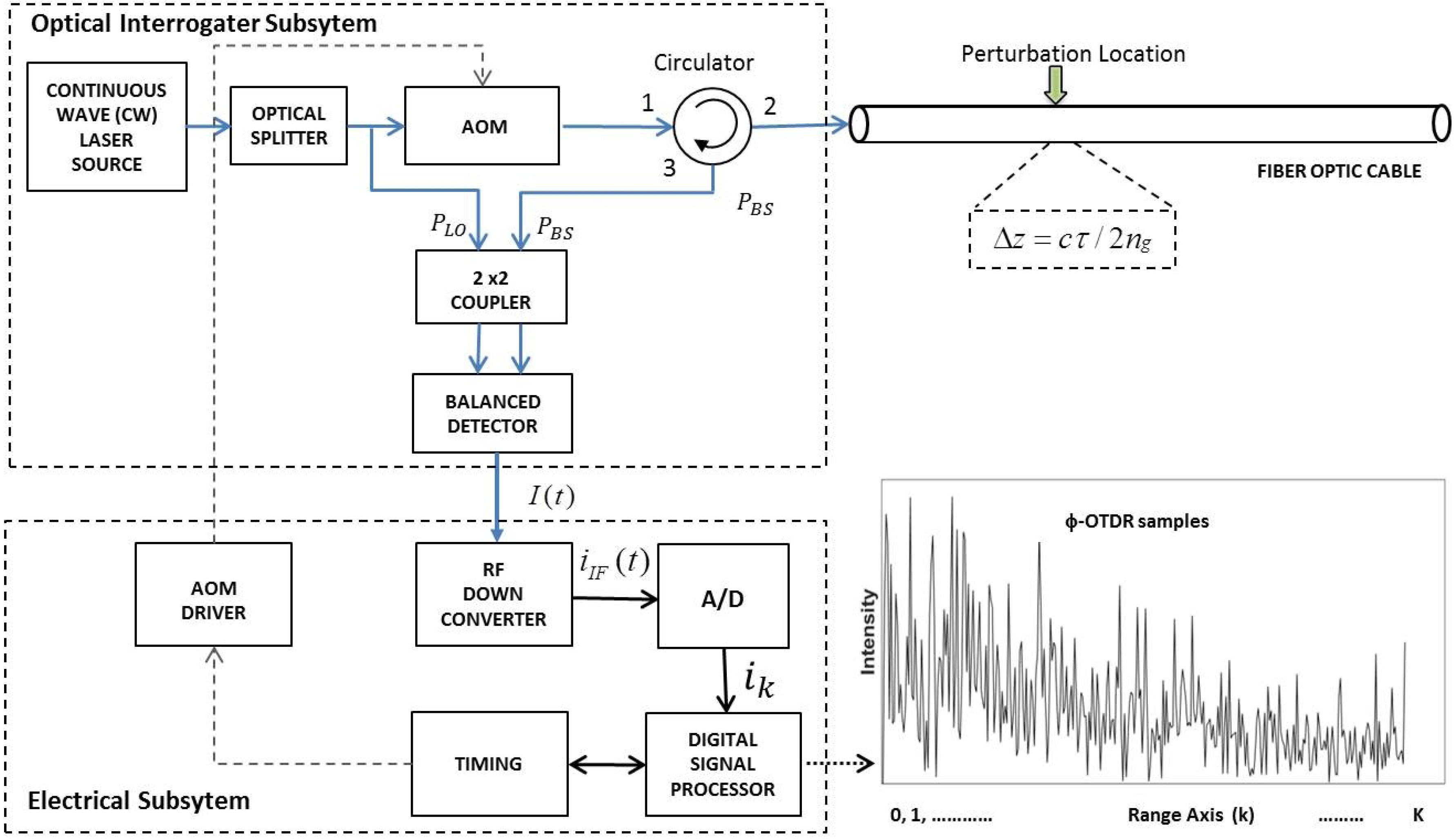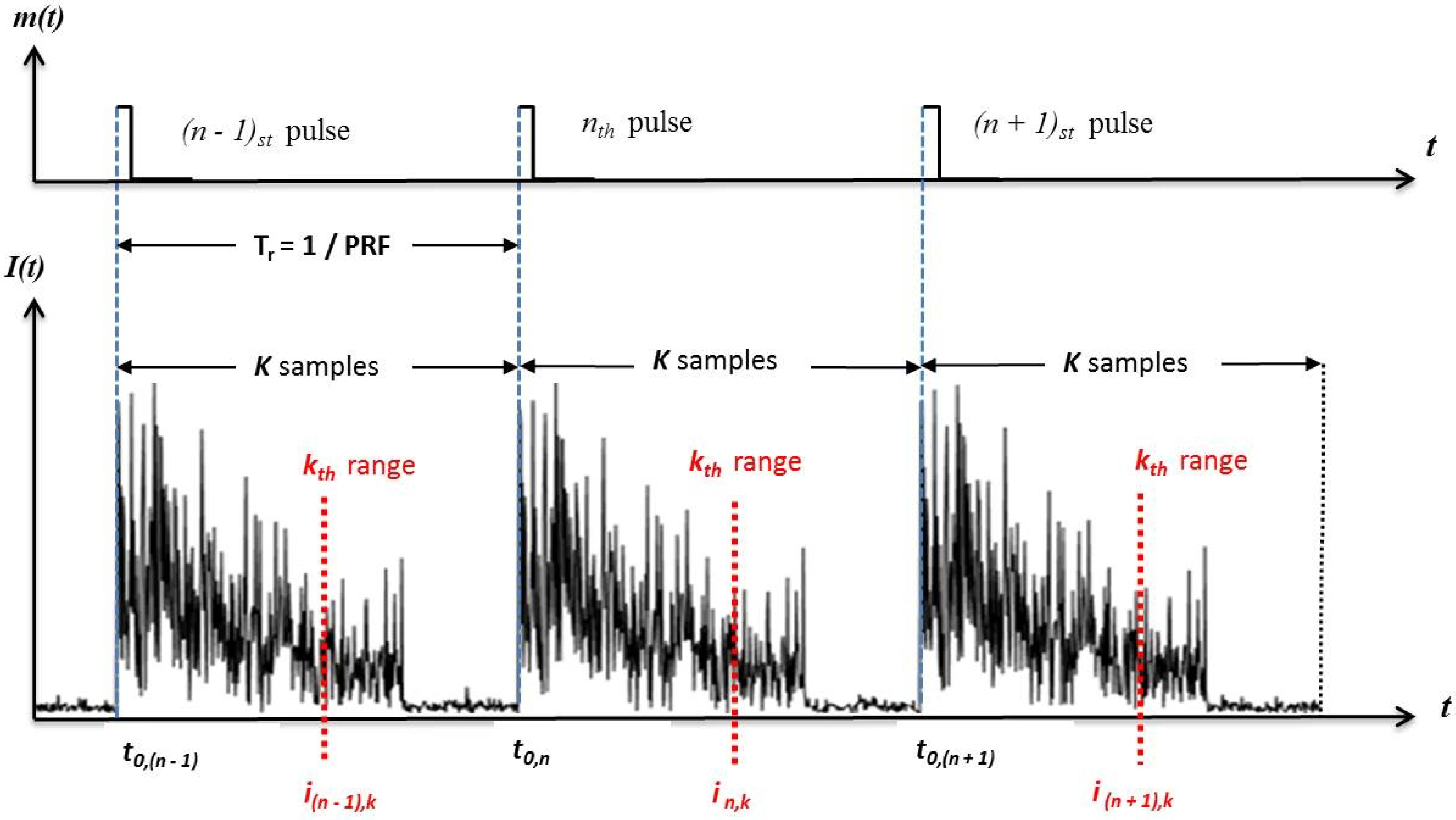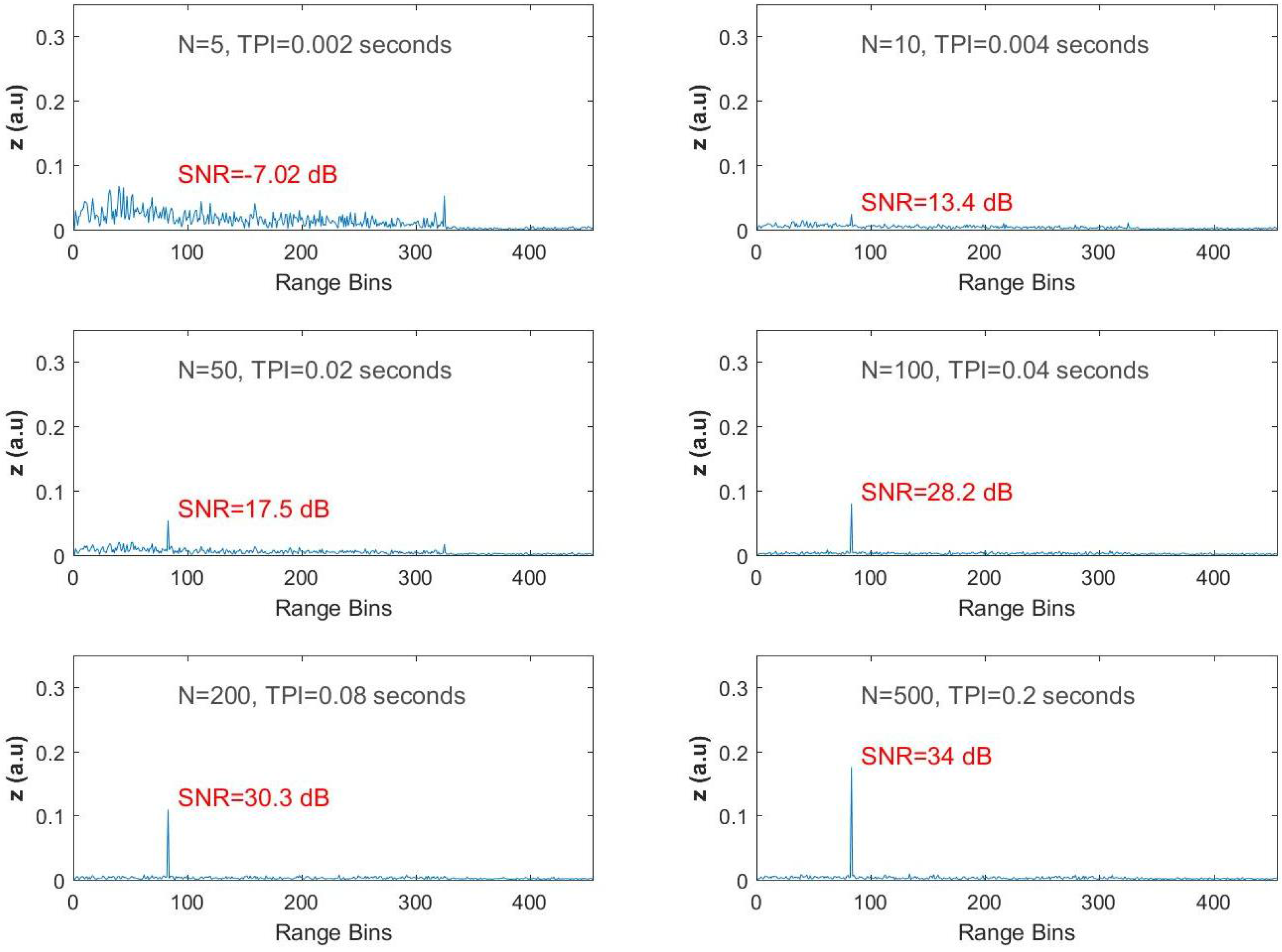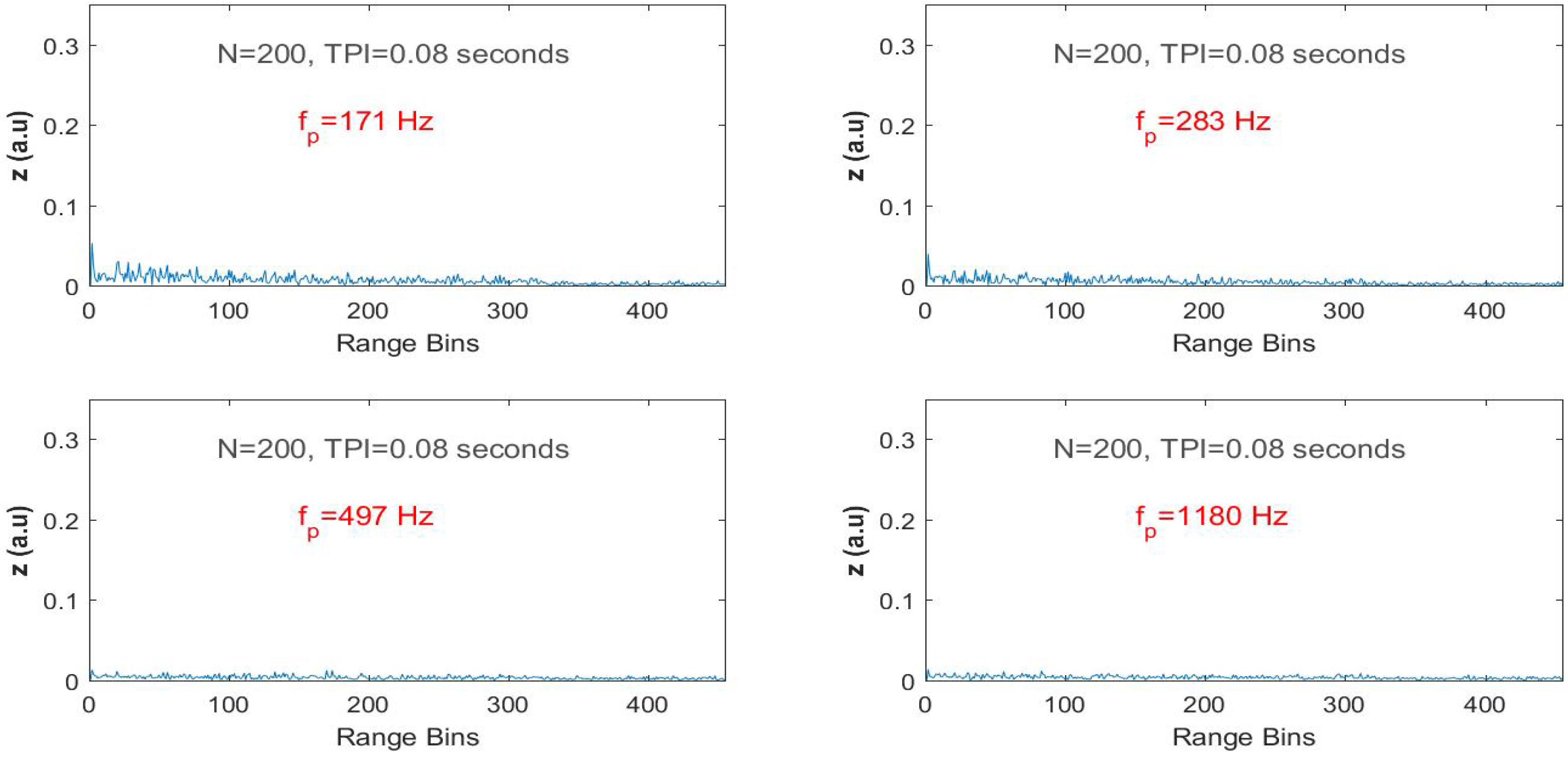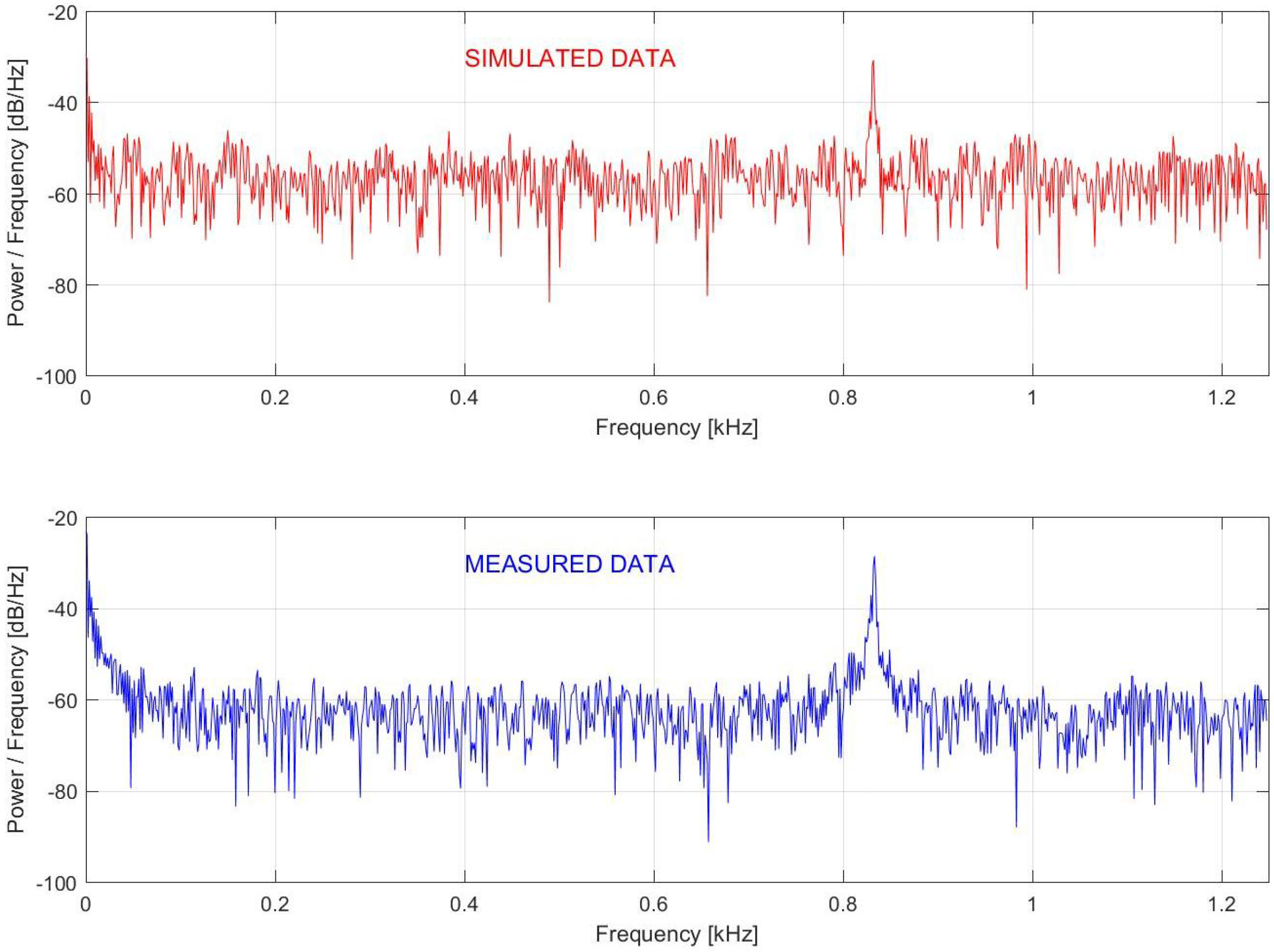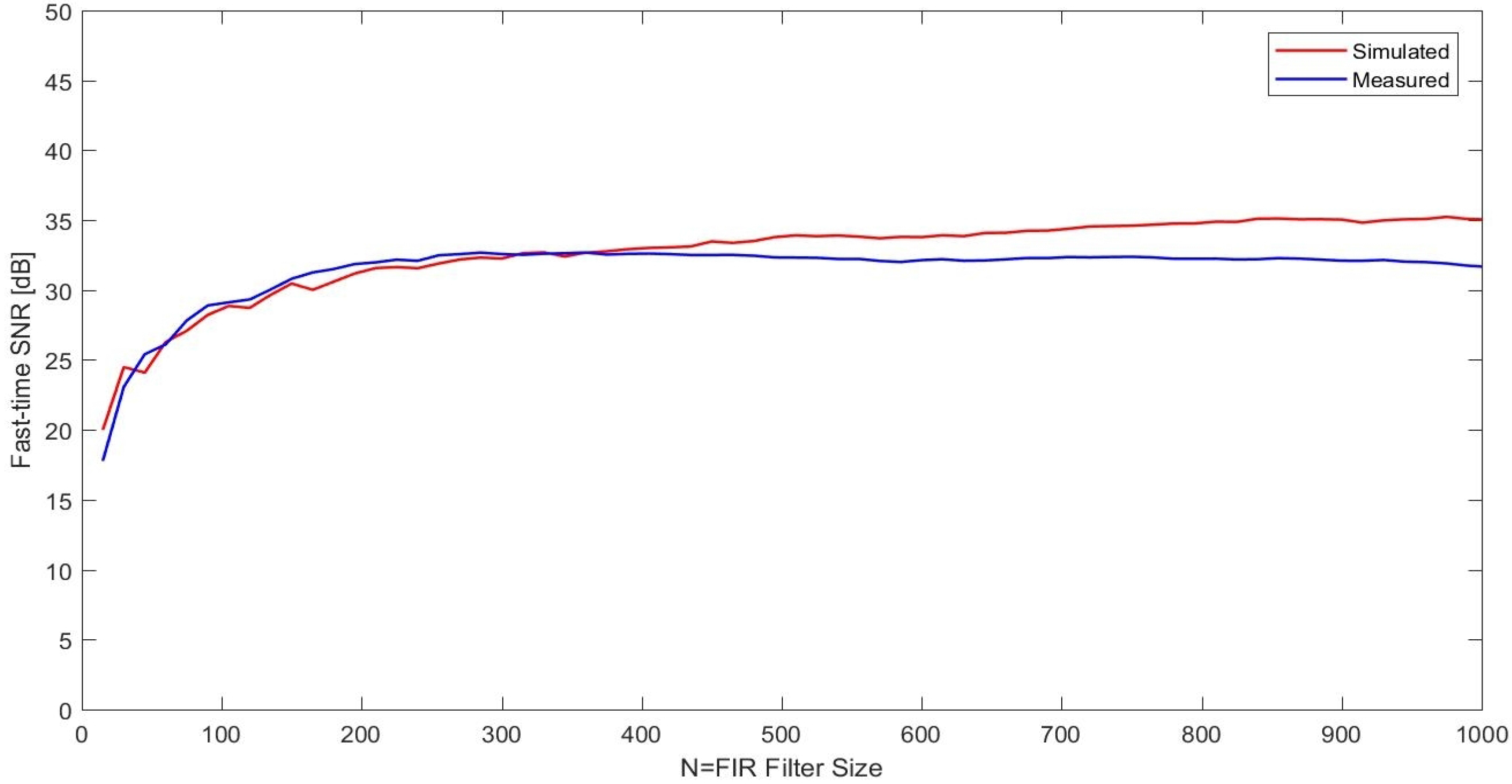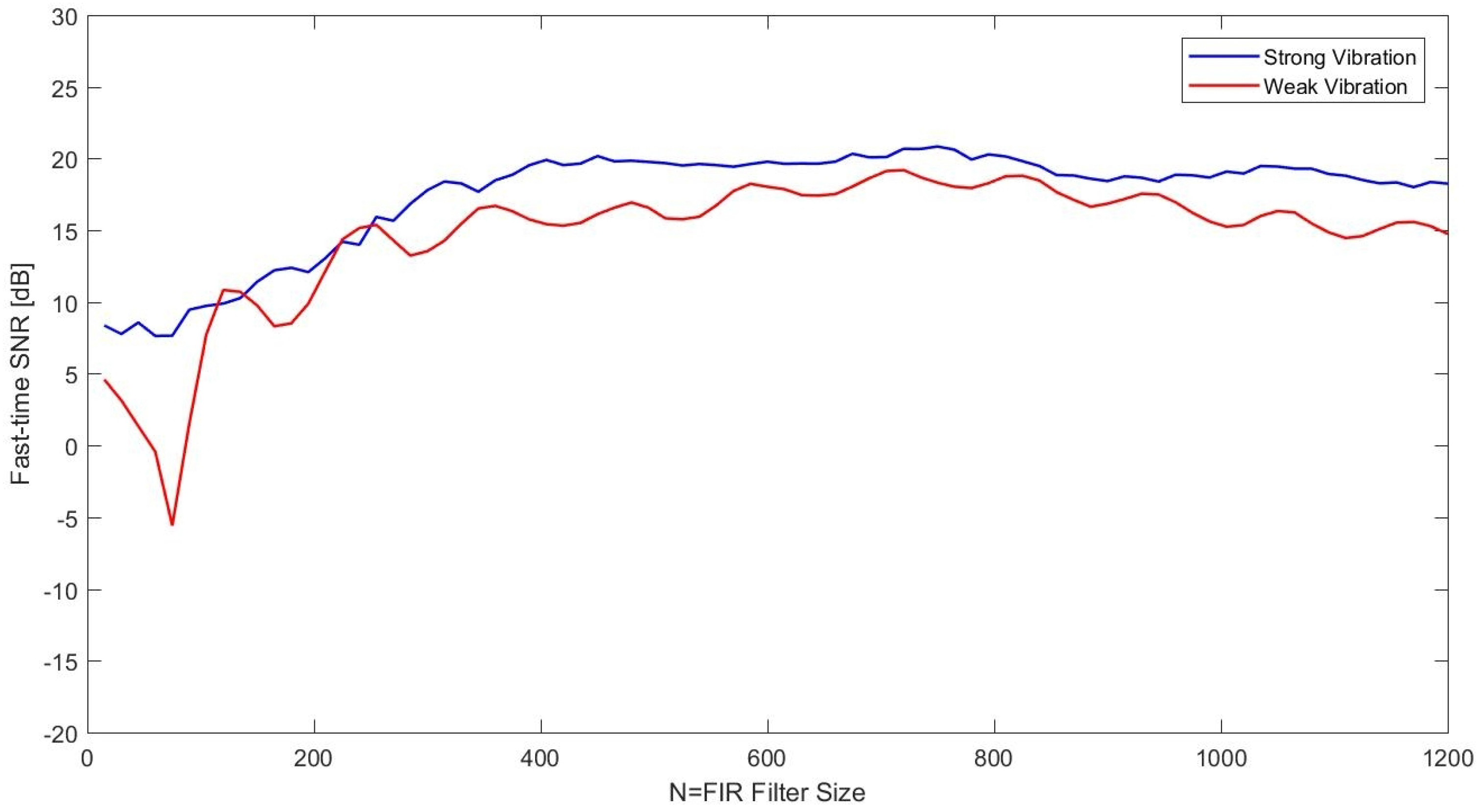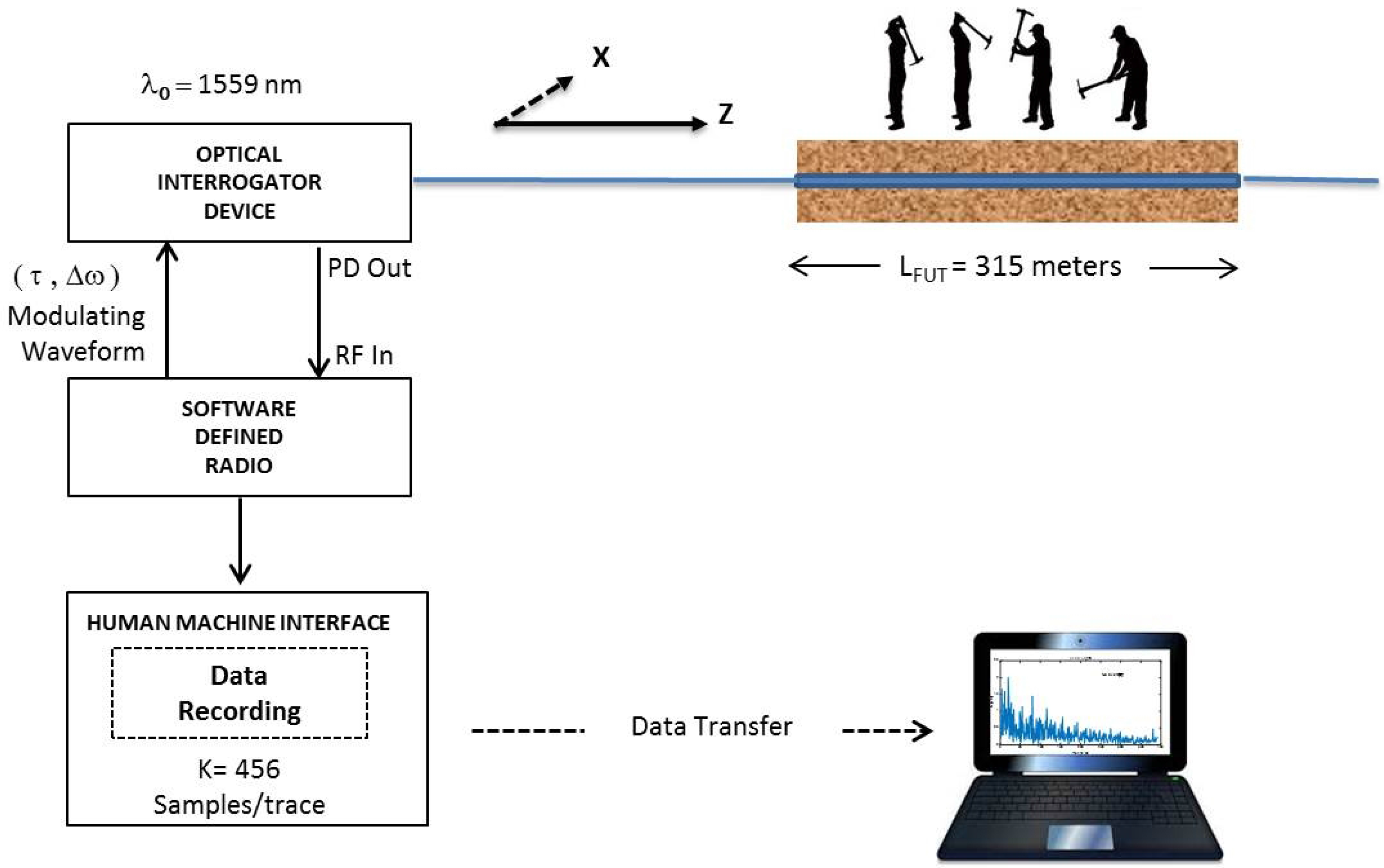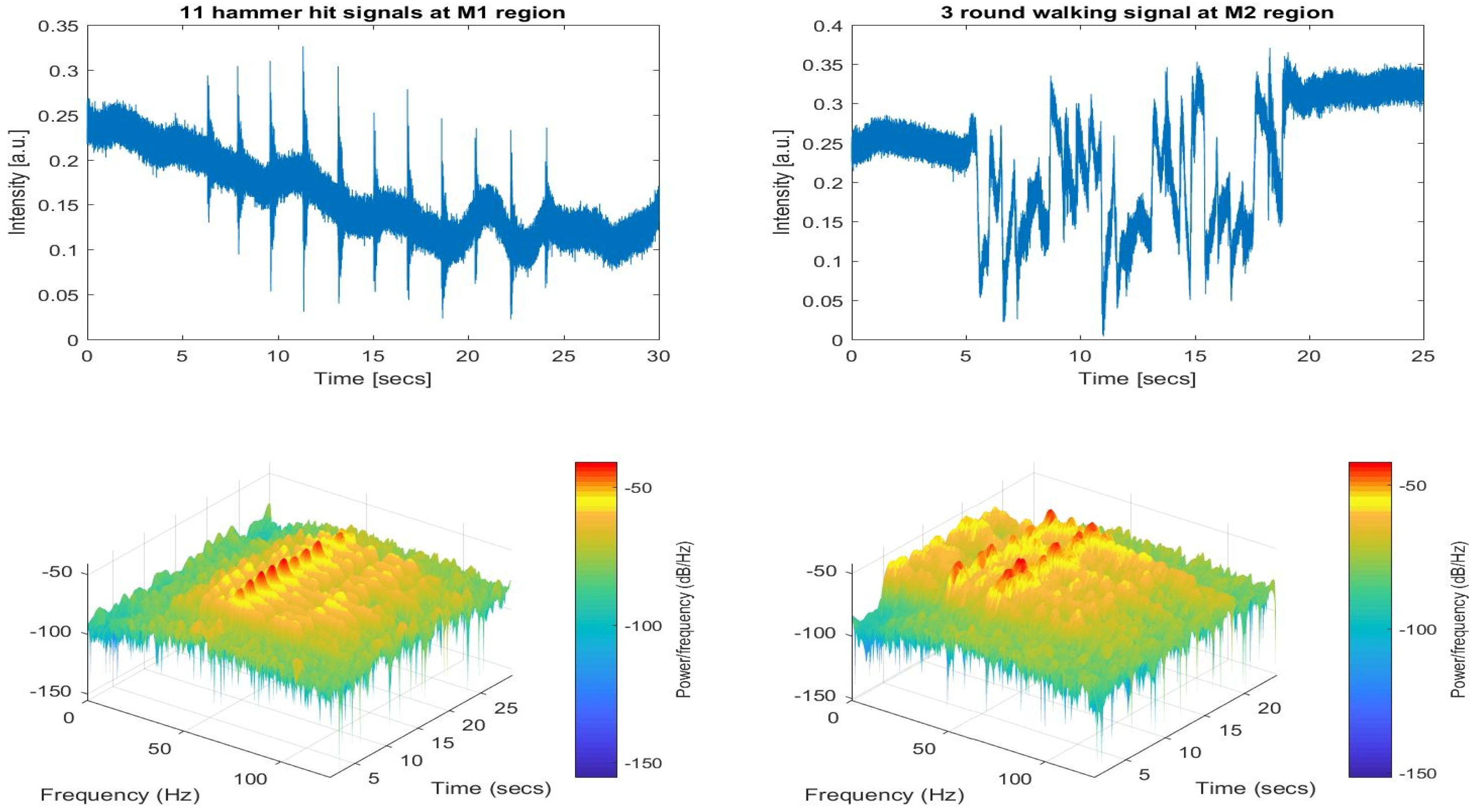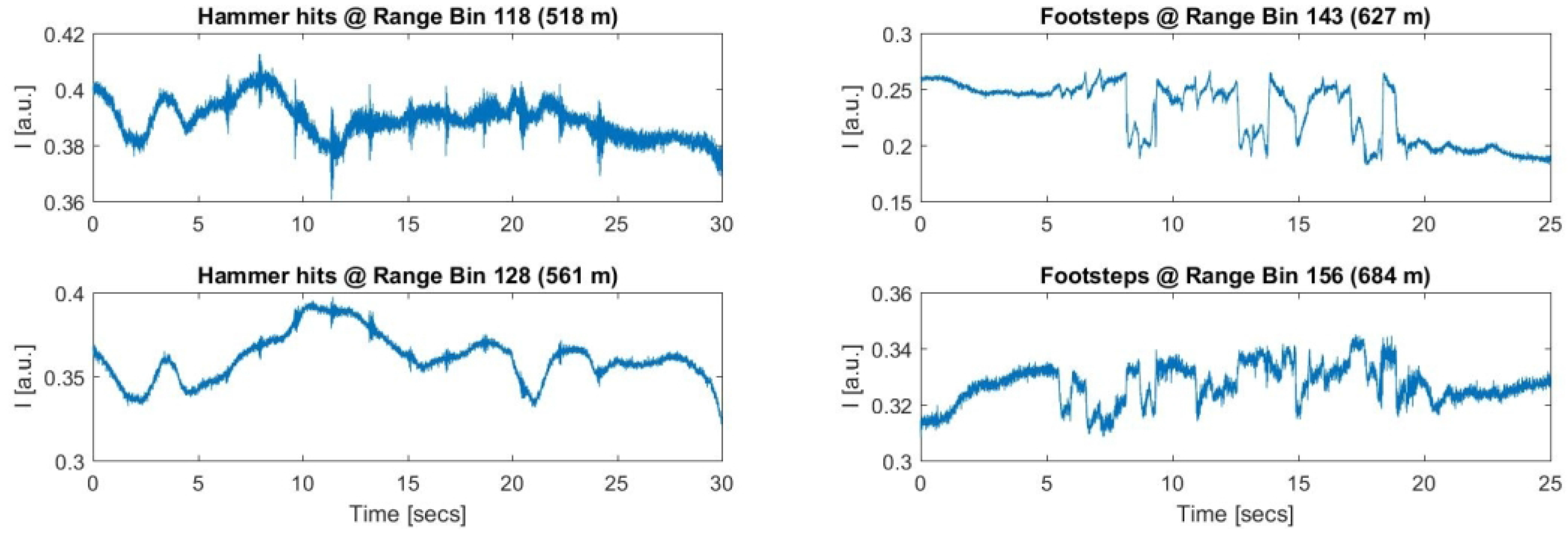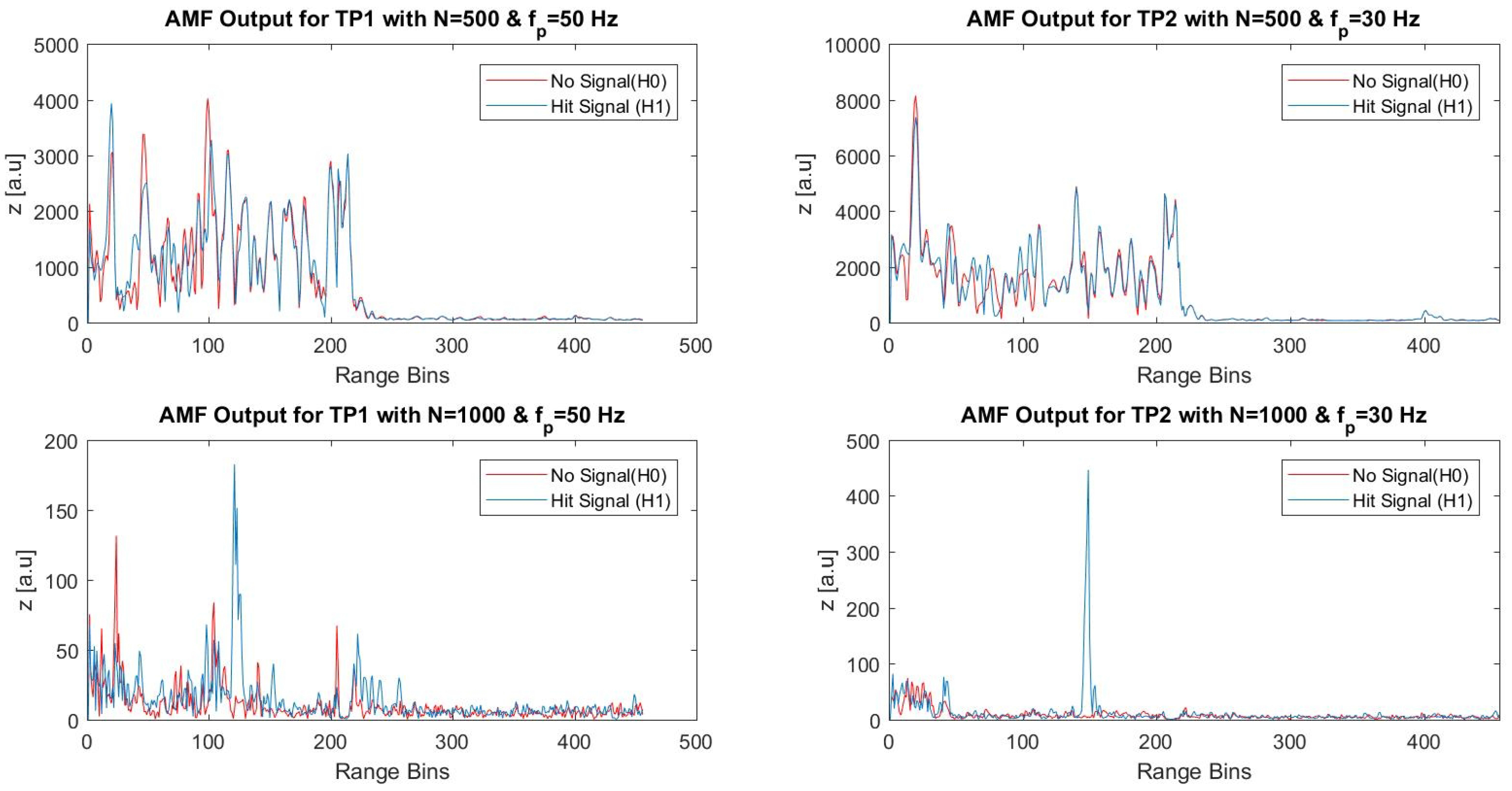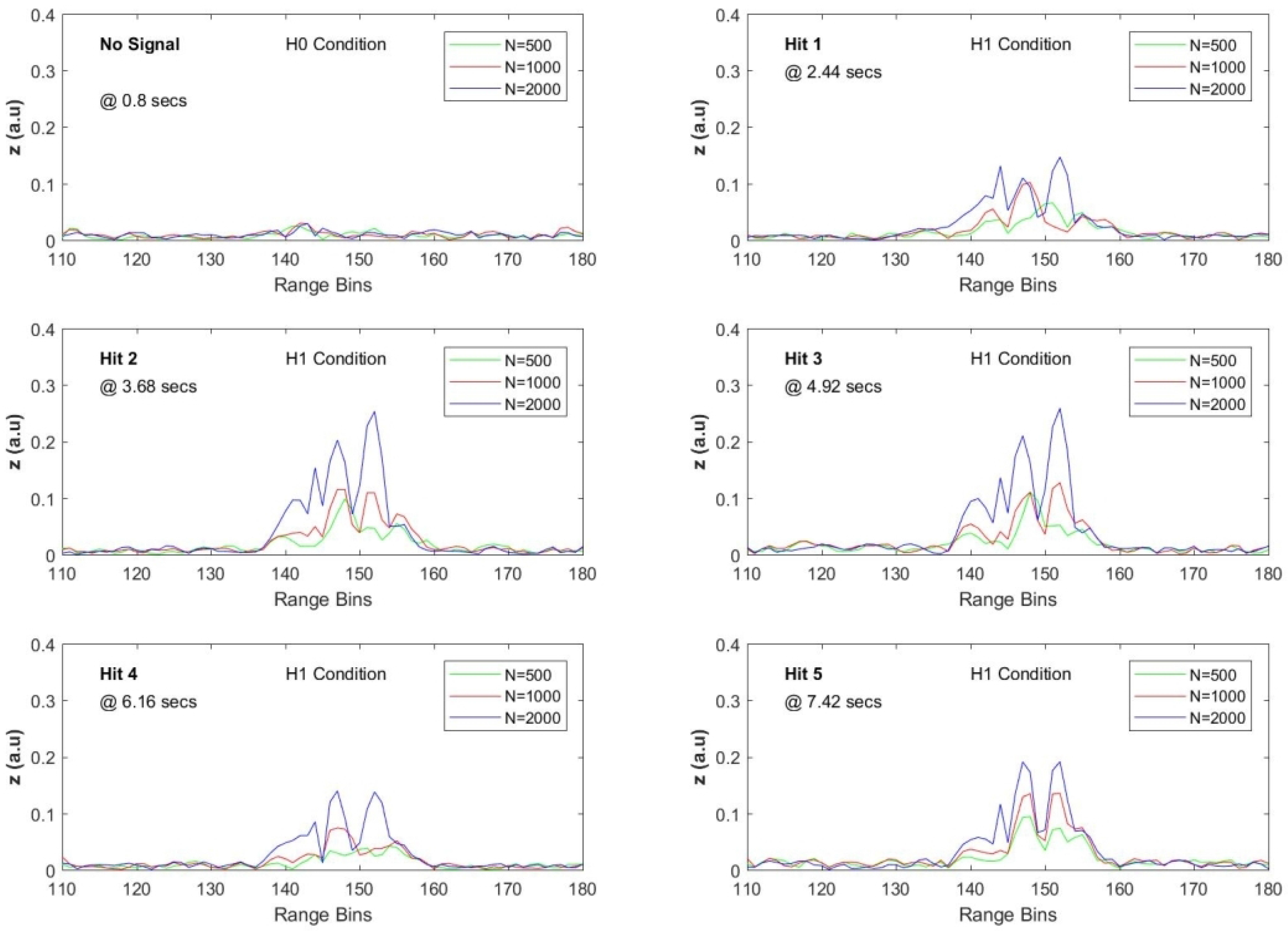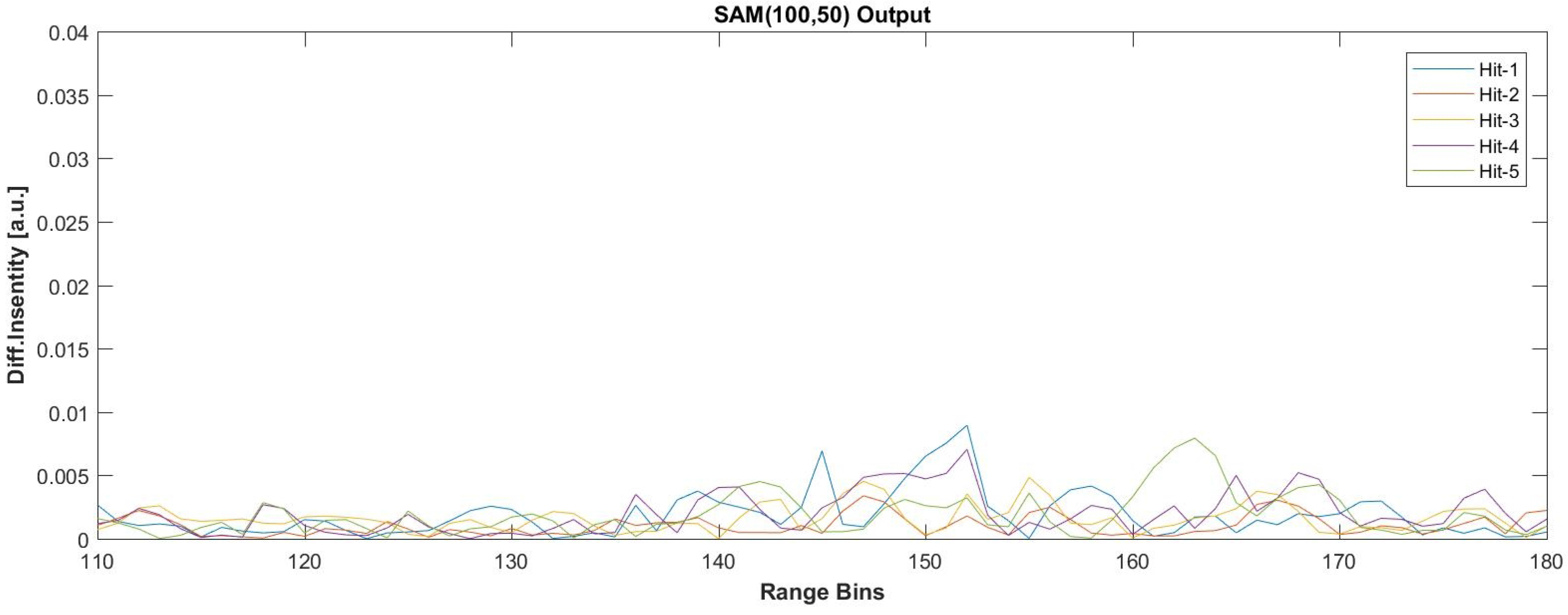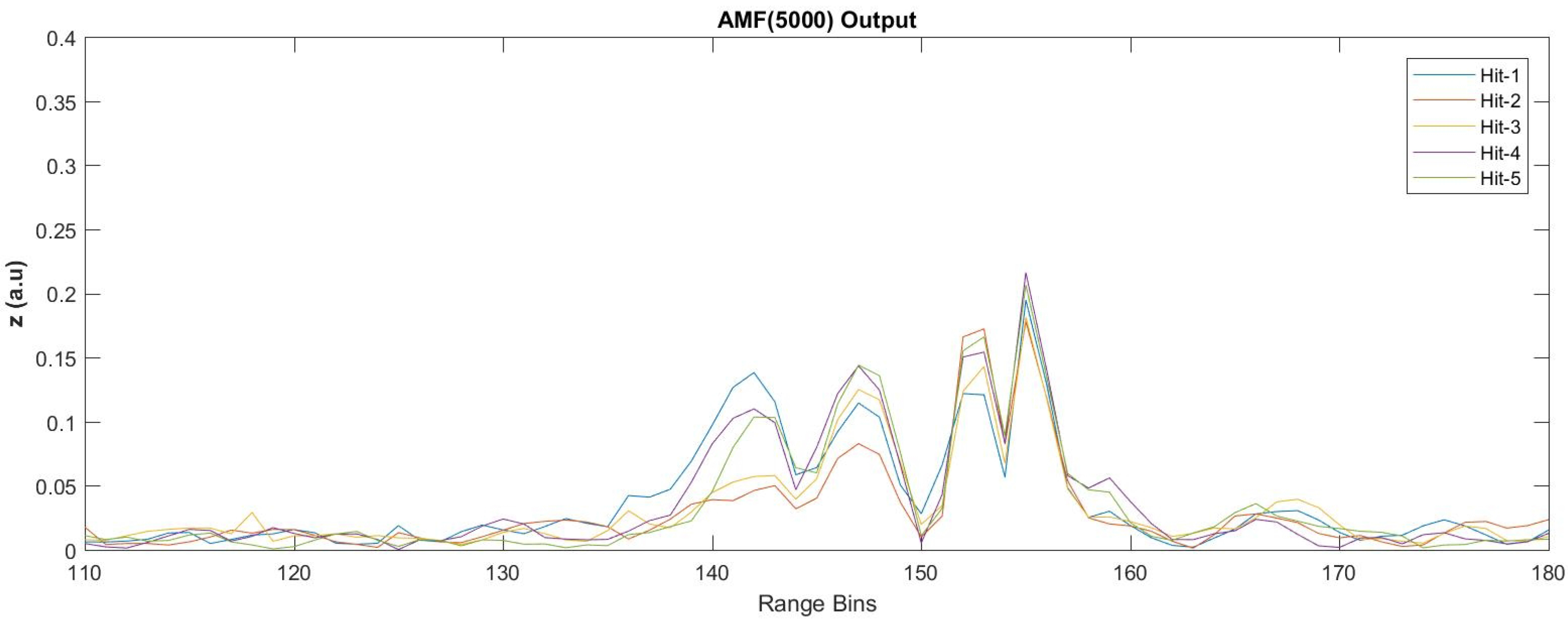3.2. Laboratory Experiments
Our experimental setup is shown in
Figure 3. The fiber under test (FUT) is a cascaded of two FO cable on reels, which are 7.24 km and 21.1 km long.
As stated above, the cascading point of FO reels was extracted outside the box to induce an acoustic vibration on the 7240-m location. For this purpose, a linear phase-shifter is used to simulate the vibration, and the frequency of the phase shift is adjusted by a function generator (i.e., the frequency of the acoustic vibration is controlled by the function generator). The output of the function generator is amplified to drive the phase shifter due to the given specifications by the vendor.
The experimental system consists of two main 19-inch rack mountable instruments. The first subsystem is called the optical interrogator device (OID) that incorporates all optical and electro-optical components of the DAS system as shown by the dashed lines in the upper left part of
Figure 1. The second subsystem is a software-defined radio (SDR)-based receiver, which is used to capture and analyze the
-OTDR signals with digital signal processing (DSP) capabilities. The OID emits optical pulses and receives the backscattered optical power in a cooperative manner with the SDR receiver.
Before the experiments, although no booster optical amplifiers were used at the transmitter stage, the peak optical power launched into the FUT was measured by an optical spectrum analyzer to verify that the system was free of the stimulated Brillouin scattering (SBS) phenomenon, which might have impairments on the received signal [
22,
23].
The SDR device is responsible for the modulation waveform parameters that are managed by the user. It incorporates a tunable radio frequency (RF) front end tunable up to 3 GHz. The IF and baseband processing section includes high-speed and high-resolution digitization (A/D) and waveform synthesis (D/A) blocks, as well as a field programmable gate array (FPGA) with on-board memory. The SDR serves as the system control unit of the whole system, which is operated via the graphical user interface (GUI) of the SDR receiver. After the electrical signal is processed by the RF front stage of the SDR, it is then digitized by a two-channel 14-bit 250 MSPS A/D and processed by the FPGA block. The baseband I/Q signal is digitally down-converted and decimated for baseband conversion. The raw data are then transferred to another personal computer to be processed in MATLAB. In this research study, the SDR device is only used to capture real-time data and to store it for subsequent processing since real-time implementation in the FPGA is still under development. After decimation, the final number of I/Q data samples recorded by the system for the experiments is 456 samples per trace.
The system parameters were set to fixed values before recording the data for different vibration frequencies. The technical specifications and the general system parameters used during experiments are summarized in
Table 1. The display range of the GUI was taken as 40 km to observe the total Rayleigh scattering profile easily along the 28.32 km-long FUT. A typical
-OTDR trace gathered from the system is shown in
Figure 4. Since the vibration is induced at 7240 m and the resolution is set to 87 m by the system, the target range bin is the 83rd bin via
where
is the integer operator.
The exponential decaying and speckle-like feature of the Rayleigh backscattering up to the end of the FUT are obvious. The total background noise is composed of the Rayleigh scattering-related part plus the receiver noise term till the end of the FUT, which is 28.32 km long. The data record in the flat region of the plot correspond only to the receiver noise terms.
The AMF approach was tested for several different vibration frequencies, but due to limited space, the results of only two different vibration frequencies are presented here. The information about these sample data records is given in
Table 2. The first frequency selected is 833.3 Hz, and it is the same vibration frequency used in our previous simulation study [
19] for comparison. The second vibration frequency is 1225 Hz, and it is selected close to the maximum detectable frequency, which is half of the PRF, i.e., 1250 Hz. The vibration frequency
is controlled by the function generator and is equal to the frequency of the sinusoidal waveform used to modulate the phase shifter.
After raw
-OTDR data are recorded by the SDR, they are subjected to off-line adaptive processing (i.e., MATLAB routines) with different processing times. The results are summarized in
Figure 5 and
Figure 6. The algorithm was run several times with FIR filter sizes (i.e., TPI lengths), and the first three range bins on the FUT axis were selected as the training region, i.e.,
. Taking a fixed region for secondary data is a realistic approach since all of the fiber optic cable reels were in the same environment, which forms a homogeneous background, and there is no need to move this training window on the sensing fiber axis.
In the first experiment, the frequency of the function generator, which drives the phase shifter located at the 83rd bin was set to 833.33 Hz, and data were recorded for about 6.8 s. In the first dataset, the total number of
-OTDR traces was 17,043. The adaptive processing was applied, and filtered
-OTDR traces were obtained for every range bin by setting the tuning frequency of our steering vector equal to the vibration frequency of 833.33 Hz. As mentioned earlier in this text, the performance criterion is to observe the SNR at the output of the filter along the FUT axis. Thus, by remembering Equation (
5), the fast-time SNR value after AMF processing is calculated via:
where
L is the total number of range bins along the FUT, and it is smaller than the total number of range bins recorded. In the data recordings,
L was computed as 326 according to the total length of the FUT and the spatial resolution, which were 28,340 m and 87 m, respectively (i.e.,
(28,340/87) = 326). It is worth noting that all
values are computed via Equation (
6), which inheres the dependency of
N in the SNR computations.
The computational results of Equation (
16) for various values of
N are displayed in
Figure 6, ranging from the top to the bottom and left to the right for increasing
N, which corresponds to increasing TPI. When the size of the input vector of the FIR filter is equal to five (i.e.,
and TPI = 2 ms) there is significant reduction in the speckle like profile of the
-OTDR trace, but no peaks are observed along the range axis, while the calculated SNR is 0.043 dB for the vibration point. Although the SNR is calculated as 7.81 dB when is
N increased two-fold, no peaks are observed. When
and the resulting TPI duration is increased to 0.02 s, the expected peak at the 83rd range bin is revealed with a resulting SNR value of 22.5 dB.
For the last three trials, the size of the filter is selected as 100, 200 and 500, and the observed SNR values are 27.1 dB, 31.2 dB and 33.9 dB, respectively. As can be easily seen from the filter outputs given in
Figure 5, the peak at the 83rd range bin becomes obvious, while the background noise is severely suppressed with increasing
N.
The same steps were repeated for the second dataset recorded when
= 1225 Hz and with the test frequency equal to 1225 Hz. For
, the SNR is −7.02 dB, and there is not enough reduction in the background noise to reveal the vibration signal. A high reflection is observed at the end of the FO cable. However, when the size of the FIR filter is increased to 10, the peak is slightly clear at the 83rd bin. For
, the peak is observed with an SNR value of 17.5 dB. As
N is increased to 100, 200 and 500, the results are similar to the ones obtained for the previous data with the fast-time SNR values of 28.2 dB, 30.3 dB and 34 dB, respectively, as shown in
Figure 6.
For the second dataset, the filter outputs were tested for some arbitrary frequencies that are not equal to the vibration frequency such as 171 Hz, 283 Hz, 497 Hz and 1180 Hz. It can be seen in
Figure 7 that none of these tuned frequencies yielded spikes at the output of the FIR filter. As the algorithm seeks vibrations over all range bins, the filter output is only maximized when the test frequency matches the real vibration.
The measurement results were compared with the results of the previous simulation study [
19]. In that previous research, Monte Carlo simulations were carried out with the same system parameters of the experimental setup. The simulation study was based on the theoretical model given in [
8].
For this comparison, the fast Fourier transform (FFT)-based power spectrum of the 83rd bin with 1000 consecutive
-OTDR traces was used. As can be seen in
Figure 8, both simulated and measured data yielded a peak at 0.83 kHz, which is equal to the vibration frequency.
After observing the periodograms, the AMF algorithm was executed for both measured and simulated datasets for increasing
N. The SNR versus
N plots are given in
Figure 9. It can be concluded in general that the simulation results are in good agreement with the experimental results. The main difference seems to be the relative asymptotic behavior in the measurement data compared to the simulation results.
For the second phase of the indoor experiments, the AMF method was tested with the acoustic enclosure removed. Two different vibration datasets were recorded with the 833-Hz vibration turned on for approximately 3 s to emulate “strong” and “weak” non-continuous vibrations. For the strong vibration case, the amplitude of the signal generator was adjusted to a level that the spectrum of the signal exhibits a visible peak. For the weak vibration case, the amplitude was decreased to a level where the peak is obscured by the noise spectrum. The spectrogram plots computed in MATLAB are presented in the upper row of
Figure 10. The periodograms were computed for only the signal durations to verify the visibility of the signals. As shown in the lower row of
Figure 10, the SNR in the strong signal case is about 15 dB over the noise floor. From the graph presented in the lower right part of the figure, it is impossible to decide on the presence of a vibrating signal with the power spectrum.
The fast-time SNR values versus FIR size were computed for both strong and weak signal conditions. It can be seen from
Figure 11 that the trend of the SNR curve is similar to those obtained for the measured data with acoustic isolation. There is a negative offset in the SNR axis, which can be expected due to the reduced power of vibration signal. The only interesting point observed was the oscillating behavior of the SNR curve for the weak signal test.
The AMF output was tested for various FIR sizes for the weak vibration.
Figure 12 presents the output intensity profiles obtained for the same set of
N values as previously selected. For the weak vibration, the peak at the 83rd range bin is not observed unless
N = 200, but it is not very dominant since the next peak on the left seems to be another candidate, which may cause a false alarm. The significant noise reduction is obtained, and the vibration is clearly emphasized when
N = 500.
3.3. Field Tests
To validate the proposed approach in real-world conditions, field tests with a real fiber optic bundle buried approximately 0.5 m underground were carried out on the TÜBİTAK (The Scientific and Technological Research Council of Turkey) campus site located in Gebze. The acoustic enclosure and the fiber on reels were removed from the experimental setup, and the
-OTDR system was connected to the buried fiber through a patch panel in the office area as depicted in
Figure 13. The route of this selected intranet line between two facilities is roughly illustrated in
Figure 14. The FO bundle consists of 12 different thick coated SMF cables that were installed with a protection sheath made of steel. One spare fiber cable was selected as the FUT to observe the sensitivity of this telecommunication line for a potential DAS application. The exact length of the FUT was estimated as 987 m via our
-OTDR system screen as shown in
Figure 15. Before the field tests, several manholes were inspected to verify the route and to assign the correct range bin locations on the observed OTDR traces. The starting and ending range of the effective buried length was estimated as 540 and 855 m, respectively, by perturbing the manhole covers with footsteps. Several tests were conducted between the dates of 19 April 2017 and 3 May 2017 with this buried FUT, and real
-OTDR data were recorded during two weeks at different locations and with varying distances from the FUT. Due to the limited scope, only the results of the four data summarized in
Table 3 are presented in this paper.
Since the effective test length of the FUT was only about 315 m, by adjusting the OID and SDR parameters, the spatial resolution was increased to 25 m by reducing the laser pulse width to 244 ns. Oversampling was performed for better visualization of the results on the range gates of interest. Due to the on-board storage limitations of the DSP hardware, the recorded range was fixed to 2000 m with 456 samples per every OTDR trace independently from the adjusted PRF. This synthetic enhancement of the SR with
= 2000/456 = 4.39 m is the result of the oversampling, and it is higher than the actual SR of the system. All other system parameters were kept the same as before. The modified system parameters used during field tests are summarized in
Table 4.
The first two field datasets were recorded with strong perturbations to observe the spectrum of the vibrations in close vicinity of the buried cable. The data shown in left column of
Figure 16 refer to the intensities of the signal recorded at the first test point (TP1), while the gravel path 2 m away from the manhole was hit with a big hammer.
As can be seen from the intensity profile in the graph, the total of 11 sequential hits is considerably strong and easily “heard” by the FUT in the 123rd range bin. The time-frequency analysis shows that most of the signal energy is concentrated in the 20 Hz–100 Hz region giving a dominant peak around 50 Hz. The second field dataset was recorded while a 90-kg man circled the second manhole three times with uniform footsteps as illustrated on the right side of
Figure 16. Similarly, the presence of a signal component is obvious both in the time domain and the frequency domain plots. Two dominant peaks were observed around 30 Hz and 45 Hz, as can be seen from the spectrogram processing of the footsteps.
The analysis of the raw
-OTDR data for each range bin revealed that the induced acoustic energy on the FUT was spread on several range bins. The strongest signals recorded for the first and the second manholes were observed on 123rd and 147th range bins, respectively. The distance between the two range bins were computed as (147 − 123)
= 105.3 m, which was consistent with the measured distance of 104 m, as depicted in
Figure 14. The range bins with the weakest contributions were noted along the FUT for every test during the experiments. To give more insight about the amount of energy coupled to the neighboring range bins, the range bin recordings with the least visible signals are plotted in
Figure 17. All of the hammer hits are weakly heard by the 118th and 128th range bins. Thus, the vibrations were spread over a range of (128 − 118 )
= 43.9 m. For the walking experiment conducted at TP2, the footstep signals are visible along a range of 684 m − 627 m = 57 m, as can be seen from the right side of the
Figure 17, with the corresponding range bins of 156 and 143.
The field data were subject to the AMF approach with similar steps followed before. The vibration signals recorded during field tests were no longer pure continuous sinusoidal signals. In order to analyze the “noise only” and “signal presence” cases with the AMF approach, the start of and the end of the durations of each signal shot were noted, and the AMF method was tested with the observed peak frequencies. For the fifth dataset, the first 400 ms of the record and the 400 ms duration of the sixth hammer hit were selected as inputs to the FIR filter in order to analyze the tested noise only (
) and signal presence (
) conditions. Since the dominant vibration was observed at 50 Hz for this dataset, the AMF method was tested with the FIR tuned to 50 Hz. From the results shown in
Figure 18, the speckle profile was still dominant, although the FIR size was set to
N = 500. It has been observed after several trials that significant noise suppression was obtained when
N reaches 1000. Almost similar results were observed with the sixth dataset when the FIR was tuned 30 Hz, as shown in the right column of
Figure 18. All of the range bins along the FUT were tested with the same FIR size and the test frequencies. The maxima of the FIR output were observed at the correct range bins as shown by the blue lines: the peak for the fifth dataset was observed around the 123rd range bin, and the peak for the sixth dataset was obtained around the 147th range bin as expected. The FIR outputs responded with no peaks for the “noise only” cases, which are shown by red lines in the lower row of
Figure 18.
The last step was dedicated to the testing of the AMF method for weak signal conditions. In order to meet the noisy case, the test distances from the FUT were increased step by step where the acoustic vibrations on the relevant range bins became hardly seen by the operator on the system monitor. The system parameters were set to display the differences of averaged measured -OTDR traces with an averaging number ranging from 10 to 100, which was adjustable in real time by the operator. After the desired conditions were met, the tests were repeated to record the raw data without any averaging or any other preprocessing.
The recorded raw data shown in
Figure 19 below were gathered seven days after the above presented recordings in almost similar environmental conditions. The first data shown in the left side of the figure are the recording of five sequential hammer hits at a lateral distance of 20 m from the second manhole (seventh dataset), while the second data shown on the right side of the figure are the recording of another five sequential hammer hits gathered at a lateral distance of 25 m from the same manhole (eighth dataset).
The upper row presents the original record, while the lower row shows the processed versions of the same data with an average size of 100. As can be seen in the upper right plot, the hammer hits recorded at 25 m were highly obscured by noise that can be considered as a very weak signal condition since these signals became visible only when sufficient averaging was applied. Before applying the whole data record to the FIR filtering with appropriately selected FIR sizes and the vibration frequency, it was considered first to analyze the fast-time SNR values for every signal. As the start and the durations were noted on the enhanced signal, these time indices and duration values were used to test the output of the AMF for all conditions. In order to compare the AMF with the conventional averaging techniques, the fast-time SNR was used as a figure of merit as mentioned before. The signal range bin set for was collected with { 138,...,156 }, while all other range bins along the “effective” FUT axis were taken for computation of the noise energy. Thus, the noise range bin set is the union of neighboring regions {110,...,137} and {157,...,180}.
The noise only condition and the five different signal presence conditions were tested with three different FIR sizes when the steering vector was tuned to 50 Hz. The results obtained for the seventh dataset are given in
Figure 20, and the comparison of SNR values with the SAM is listed in
Table 5. The original raw data were processed with three different FIR sizes as 500, 1000 and 2000. The SAM method was applied with various pairs of (
) values, (i.e., SAM(
)) where
M denotes the averaging block size and
L is the lag value used in sequentially differentiating the
-OTDR traces. After several trials with the 7th dataset, the relatively high SNR results obtained via SAM(100,50) and SAM(200,15) were selected for comparison, which are given in
Table 5. For the proposed AMF method, the results show that significant SNR improvement is achieved with all selected FIR sizes, but a clear superiority to SAM(
) is achieved when
N is increased over 1000.
The AMF outputs and the SNR values computed for the last data are shown in
Figure 21 and listed in
Table 6, respectively. For the SAM(
) method, after several trials with various average size and lag values, it was observed that the best SNR performance was achieved with SAM(200,15). The noise contamination for these data is more severe compared to the previous dataset, and significant noise reduction performance is achieved when
N is selected over 2000 for the AMF method. More than 10 dB of SNR values can be easily obtained by increasing the FIR size over 3000 with penalties in processing times.
3.4. Discussion
For the data gathered indoors with the acoustic isolation, it can be easily deduced from the results that the vibration is not solely observable unless the N, the FIR vector size (or in other words, the number of consecutive -OTDR traces processed at the same time), is over 50. When N is increased to values higher than 100, the amount of speckle reduction is significant, which means that the term of the background noise is highly suppressed. When the acoustic isolation is removed and the vibration intensity is reduced to lower levels, more than a 10-dB speckle reduction can only be achieved with a much higher value of N. This is expected since both simulation data and the measurement data with isolation present the ideal situation. When the isolation is removed, the whole FUT is subject to more interference, and the vibration signal is highly obscured by the increased amplitude fluctuations of the -OTDR traces.
All field tests yielded the same results, and the vibration energy is better visualized when the FIR size is increased. We can say that the longer the AMF processing interval, the better the speckle reduction is. It is very clear from the test results that an FIR size of at least 1000 seems to be mandatory to reach a minimum SNR level of 10 dB for weak signal detection. On the other hand, when we are only concerned with the real measurement data, the processing time and computational load will increase with increasing N; it will not be more beneficial to use very large values of N for real-time applications. It is worth emphasizing that we did not take any care to avoid SOP changes in our setup; thus, fast-time SNR analysis for longer durations may exhibit decreasing behavior, which is another research topic for us.
Besides the computed fast-time SNR values given in
Table 5 and
Table 6, the performance of the proposed AMF approach in comparison with the SAM(
) method for the weak vibrating signal condition can be better observed with the two sample results given below.
Figure 22 presents the performance of the SAM (100,50) method for the detection of all five hammer hits in the eighth dataset. It can be easily seen from
Figure 22 that the differentiated intensity profile obtained from SAM(100,50) does not provide clear visibility for the hitting activities.
Figure 23 is the processed version of the same dataset with the AMF approach with an FIR size of 5000 and
Hz. As the noise background is highly suppressed, the acoustic vibrations distributed along the FUT axis are better visualized, and all of the five hammer hits designated by different colors in
Figure 23 are clearly detectable. The training region size selected during AMF(5000) processing was 20 (i.e.,
).
The main advantage of the AMF approach is that there is no need for trace averaging, which results in the reduction of the system bandwidth. During the field tests of weak vibrations, the PRF was set to 25 kHz, and the MDF was naturally 12.5 kHz. As an example, in order to achieve an SNR improvement of 10 dB in this scheme, then we would need to coherently sum up 100 consecutive -OTDR traces and use the average of them. This would reduce the MDF down to 12,500/100 = 125 Hz. If the vibration of interest is higher than this value, it will be impossible to detect the frequency of vibration. Thus, averaging can only enhance the SNR in terms of the spatial localization of the vibrations. In our approach, more than 10 dB of SNR improvement are achievable without any impact on the frequency response of the DAS system, and increasing the size of the FIR does not affect the system frequency response.
As a conclusion, the proposed AMF approach is superior to all conventional averaging techniques due to its capability of detecting the location and frequency at the same time while preserving the frequency response of the system. Additionally, no frequency domain analysis is required to threshold the noise components as applied in several transform domain-based techniques, such as wavelet denoising. Lastly, the achieved SNR values with large FIR filter sizes are higher than all of the reported SNR values in the literature [
9,
10,
11,
12,
13,
14,
15].
The main processing requirement of the AMF method is the need for a brute search for all possible vibrations on the frequency axis. This is not difficult with today’s technology and thanks to the high computational power brought by parallel processing capability of FPGAs and multi-core processors, such as graphics processor units (GPU). The AMF method was implemented in NVIDIA compute unified device architecture (CUDA) for using this parallel computation power of commercial of the shelf (COTS) GPUs. It has been observed that searching for all frequencies with 1-Hz resolution with N less than 500 for all 456 range bins took less than a second. During these tests, the computation of the inverse of the covariance matrix was implemented in the central processing unit (CPU), while the other necessary tasks were computed by the GPU. The platform used was a desktop computer with Intel CoreTM i7-3770K CPU (3.5 GHz CPU with 32 GB RAM) and a GeForce GTX 680 GPU having 512 CUDA cores.
We believe that the AMF is applicable not only for coherent detection-based -OTDR systems, but will be successfully applied for direct detection-based systems, as well. The underlying theory for the success of the AMF technique is that it whitens the backscattered data and applies the well-known matched filtering theory to the data. The filter is actually matched to the vibration when the tuned frequency is the vibration frequency. Since the optical Rayleigh backscattered traces are inherently correlated, the correlation canceling property of the proposed AMF is exploited very efficiently in this detection scheme. Thus, regardless of the optical detection employed in the interrogation unit, the AMF method can be applied efficiently for all types of Rayleigh scattered optical data. The validation of the AMF method for direct detection systems will be one of our next research topics.
